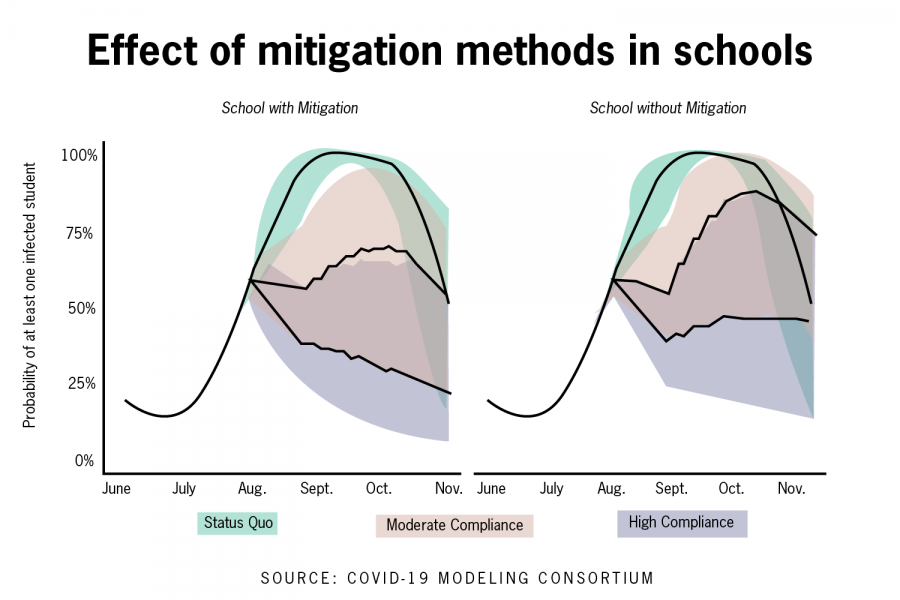UT Consortium study shows mask and mitigation effectiveness
August 23, 2021
UT researchers found in an Aug. 6 report that if schools open without COVID-19 mitigation efforts and the community does not strengthen compliance with cautionary measures such as masking and social distancing, there is a 99% chance of intensive care units exceeding capacity by Nov. 1.
The researchers modeled three scenarios for community mitigation measures: continuing precautions as they stand now, enforcing moderate compliance and enforcing high compliance. They used the scenarios to determine how school mitigation efforts would affect hospitalizations.
Under moderate community compliance with mitigation efforts during the school year, the probability of exceeding Austin ICU capacity is 59%. If schools do not implement mitigation measures, the rate increases to 69%. With high community compliance, schools can reduce the probability of overflowing ICUs to 39%. This probability increases by 5% if schools do not enforce masking and social distancing.
The researchers used hospitalization data from March 2020 to July 2021 to project hospitalizations through November 2021. They said their estimate considers the impact of the more transmissible delta variant’s spread, the start of a new school year, the mitigation measures taken, the vaccine rollout pace and the levels of precautions taken around Austin.
Gov. Greg Abbot signed an executive order banning school districts and cities from enforcing mask mandates. While many school districts have defied the order, community COVID-19 mitigation relies heavily on individual choice.
Data equity specialist Maureen Johnson-León, who co-authored the study, said the purpose of the compliance scenarios is to let people understand the impact of these behavioral changes.
“The report is really intended to outline the different scenarios with different mitigation strategies,” Johnson-León said. “We hope that it’s intended to be read by both community members so that they can inform and empower themselves, and also by decision makers so they can help support students or other communities as we’re all confronting COVID together.”
The transmission model includes characteristics of the disease, demographic information for Austin, local vaccination rates and mobility data. Postdoctoral researcher and co-author Spencer Woody said their work models transmission dynamics.
“We have everyone in the (Austin area) population as defined as either being susceptible to COVID-19 being exposed, being pre-symptomatic, asymptomatic, recovered and vaccinated as well,” Woody said. “Everyone in the whole population is assigned to one of those compartment groups, and we can use data to infer the amount of transmission going on in the community.”
The transmission model, however, was unable to determine the effectiveness of specific mitigation methods such as double masking, Woody said.
While masks and vaccinations are optional at UT, Woody said the best thing students can do to protect themselves and their communities is to receive the COVID-19 shot and continue mitigation efforts through masking and social distancing.
“I think it is really potentially harmful that we all see ourselves as just spectators of the pandemic,” Woody said. “But we’re all participants in it. And so we all have a role to play in trying to reduce the suffering of the most vulnerable people in our community.”












